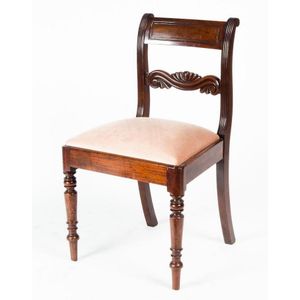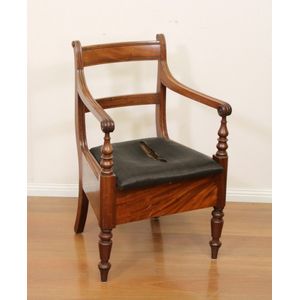Regency Mahogany Commode Chair with Fluted Runner Legs
A late Regency provincial mahogany commode chair, with fluted top runner and outswept arms on bulbous turned legs.
You must be a subscriber, and be logged in to view price and dealer details.
Subscribe Now to view actual auction price for this item
When you subscribe, you have the option of setting the currency in which to display prices to $Au, $US, $NZ or Stg.
This item has been sold, and the description, image and price are for reference purposes only.
- Runners - runnders.Runners or slides are wood on each side of the bottom of a drawer, being the surfaces which take the weight of the drawer and provide for its movement in and out. The runners of a drawer are usually the first areas of a drawer to display wear, due to the friction between the two surfaces. In modern cabinet making the wooden runners on the bottom of the drawer have been replaced by metal tracks, usually fixed to the side of the drawer and the side of the cabinet.
The timber bearers on the underside of an extension table that move horizontally against each other, thus moving the table in and out are also called runners. The number of bearers in a table will determine how far the table will extend. - Fluting - A form of decoration found on many pieces of furniture, as well as ceramics, silver and clocks, in which round-bottomed grooves, of varying width and depth, are let into columns, pilasters, legs. As a general rule, flutes are cut in the vertical, though they may follow a turned leg in a spiral pattern. In cross-section, they may be described as a series of 'U' shapes, rising and narrowing at each end of the groove. Fluting is the opposite of reeding, with which fluting is often associated.
- Regency Period - The Regency period in English furniture design refers to the period when King George III, was declared unfit to rule in 1811, and his son ruled as proxy as Prince Regent, until 1820, and then, after the death of his father as George IV until his death in 1830. The Regency period was preceded by the Georgian period (George I, George II, and George III: 1714 - 1811), and was followed by the William IV period, which only lasted until 1837 when William IV died as was succeeded by Queen Victoria.
- Mahogany - Mahogany is a dense, close grained red-coloured timber from the West Indies and Central America. It was first imported into Europe in the the early 18th century and its use continued through the 19th century. It was popular for furniture making because of its strength, the wide boards available, the distinctive grain on some boards, termed flame mahogany and the rich warm colour of the timber when it was polished.. The "flame" was produced where a limb grew out from the trunk of the tree, and this timber was usually sliced into veneers for feature panels on doors, backs and cornices.
Some terms used to describe mahogany relate to the country from which it originally came, such as "Cuban" mahogany, "Honduras" mahogany etc. However unless the wood has been tested the names assigned are more a selling feature, rather than a true indication of the timber's origin. - Turned Legs - are legs which have been turned on a lathe. In use from the 16th century, turned legs on tables, chairs and cabinets became more frequent until, by the 1830s, the Georgian square or tapered leg was rarely found except in country pieces.
- Turning - Any part of a piece of furniture that has been turned and shaped with chisels on a lathe. Turned sections include legs, columns, feet, finials, pedestals, stretchers, spindles etc. There have been many varieties and fashions over the centuries: baluster, melon, barley-sugar, bobbin, cotton-reel, rope-twist, and so on. Split turning implies a turned section that has been cut in half lengthwise and applied to a cabinet front as a false decorative support.
- Commode - The word "commode" when used to describe an item of furniture, has three usuages:
1. As used to describe an item of English furniture, it refers to what is euphemistically called a 'night table', that is a small cabinet concealing a chamber pot.
2. In its 18th century French usuage it describes a low and highly decorated chest of drawers for salons and reception rooms. A bombe commode is a commode with rounded sides and front, giving the chest a somewhat swollen look.
3. It is also used to denote a half round or serpentine shaped cabinet, with panelled doors, standing on legs. They were pieces on which the cabinetmaker lavished his most accomplished art, with rich veneers, marquetry inlays, gilt mounts and other ornamentation.
This item has been included into following indexes:
-
chairs, singles / pairs / threes, style or period
- commode chairs 14
- Regency 237
- chairs, singles / pairs / threes, timber - mahogany 1,129
Visually similar items

A Victorian rail back carver, height 83 cm
Sold by
in
for
You can display prices in $Au, $US, $NZ or Stg.

Dining Chair: English mahogany on ring turned legs with Thomas Hope scroll back, c1830s.
Sold by
in
for
You can display prices in $Au, $US, $NZ or Stg.

Gentlemans carver chair: Cedar early form with rail back, c1860s with hand cane seat & leather squab cushion, 60 x 56 x 92 cm
Sold by
in
for
You can display prices in $Au, $US, $NZ or Stg.

A19th century Australian cedar carver chair stamped (public works department) PWD. Height 91 cm
Sold by
in
for
You can display prices in $Au, $US, $NZ or Stg.
